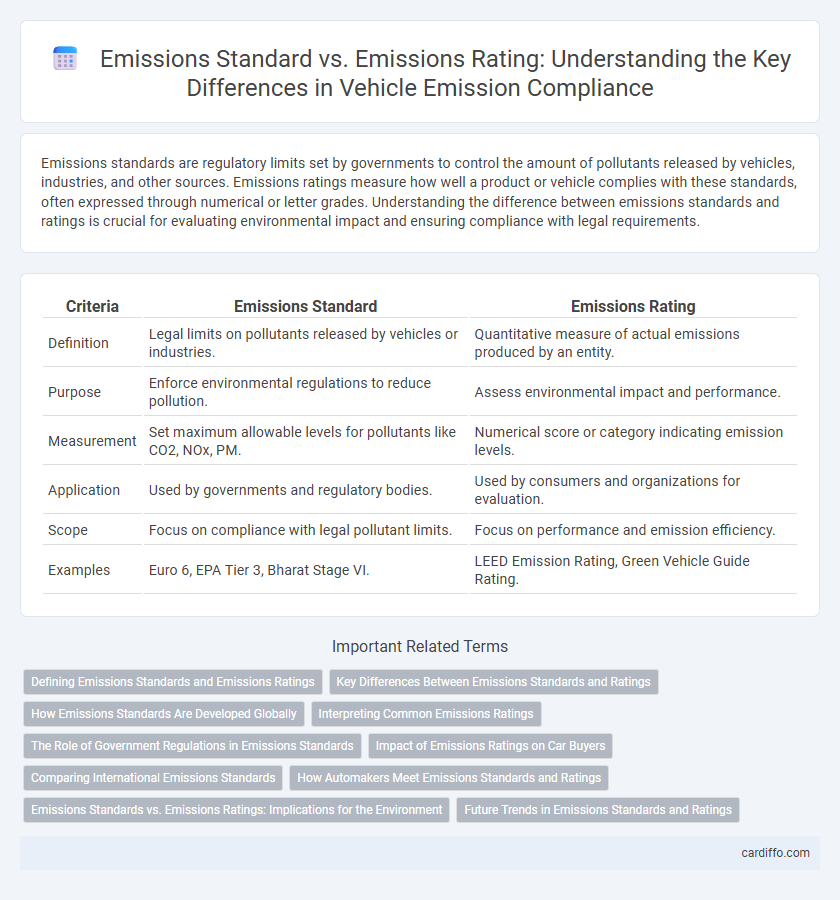Emissions standards are regulatory limits set by governments to control the amount of pollutants released by vehicles, industries, and other sources. Emissions ratings measure how well a product or vehicle complies with these standards, often expressed through numerical or letter grades. Understanding the difference between emissions standards and ratings is crucial for evaluating environmental impact and ensuring compliance with legal requirements.
Table of Comparison
| Criteria | Emissions Standard | Emissions Rating |
|---|---|---|
| Definition | Legal limits on pollutants released by vehicles or industries. | Quantitative measure of actual emissions produced by an entity. |
| Purpose | Enforce environmental regulations to reduce pollution. | Assess environmental impact and performance. |
| Measurement | Set maximum allowable levels for pollutants like CO2, NOx, PM. | Numerical score or category indicating emission levels. |
| Application | Used by governments and regulatory bodies. | Used by consumers and organizations for evaluation. |
| Scope | Focus on compliance with legal pollutant limits. | Focus on performance and emission efficiency. |
| Examples | Euro 6, EPA Tier 3, Bharat Stage VI. | LEED Emission Rating, Green Vehicle Guide Rating. |
Defining Emissions Standards and Emissions Ratings
Emissions standards are regulatory limits set by governments to control the amount of pollutants released by vehicles and industrial sources, ensuring air quality and public health protection. Emissions ratings, on the other hand, are performance evaluations that classify vehicles or machines based on their actual emissions output, often reflected in numeric scores or categories. Understanding the distinction between emissions standards as mandatory legal thresholds and emissions ratings as comparative performance measures is crucial for environmental compliance and consumer awareness.
Key Differences Between Emissions Standards and Ratings
Emissions standards are legally mandated limits set by regulatory bodies on the amount of pollutants a vehicle or industrial source can emit, ensuring compliance with environmental protection goals. Emissions ratings, however, are often voluntary evaluations or labels that indicate the relative environmental performance or pollution level of a product based on testing or certification schemes. The key difference lies in emissions standards being enforceable regulations with specific pollutant thresholds, while emissions ratings serve as guidance tools for consumers and stakeholders to compare environmental impact.
How Emissions Standards Are Developed Globally
Emissions standards are developed through international agreements and national regulations that set specific limits on pollutants released by vehicles and industries to protect air quality and public health. Agencies such as the Environmental Protection Agency (EPA) in the United States, the European Union's Euro emission standards, and China's Ministry of Ecology and Environment establish these limits based on scientific research and technological capabilities. These globally coordinated standards drive innovation in cleaner technologies and provide benchmarks for emissions ratings used to evaluate individual vehicles or products.
Interpreting Common Emissions Ratings
Emissions standards define the legal limits for pollutants released by vehicles and industrial processes, serving as benchmarks for environmental compliance. Emissions ratings interpret these standards by categorizing vehicles or equipment based on their measured pollutant output, such as CO2, NOx, or particulate matter levels. Understanding common emissions ratings like Euro 6, LEV III, or Tier 3 helps consumers and regulators evaluate environmental impact and ensure adherence to regulatory policies.
The Role of Government Regulations in Emissions Standards
Government regulations play a critical role in setting stringent emissions standards that dictate the allowable limits of pollutants released by vehicles and industries. Emissions standards are legally enforced benchmarks designed to reduce harmful environmental impact, whereas emissions ratings often serve as comparative measures for consumers. By establishing these standards, governments drive technological innovation and compliance, ensuring cleaner air quality and public health protection.
Impact of Emissions Ratings on Car Buyers
Emissions ratings provide car buyers with clear, quantifiable data on a vehicle's environmental impact, influencing purchasing decisions by highlighting fuel efficiency and pollutant output. Unlike emissions standards, which set regulatory limits, ratings offer a comparative scale enabling consumers to choose cleaner cars and reduce their carbon footprint. This transparency drives demand for low-emission vehicles, accelerating the shift towards sustainable transportation.
Comparing International Emissions Standards
International emissions standards vary significantly by region, with the European Union's Euro standards, the United States' EPA regulations, and China's China 6 norms representing leading benchmarks in vehicle emissions control. Euro standards emphasize particulate matter and nitrogen oxides limits, whereas EPA regulations integrate comprehensive testing cycles including real driving emissions. China's standards align closely with Euro 6 but incorporate stricter enforcement measures, reflecting regional priorities in air quality management and technological adaptation.
How Automakers Meet Emissions Standards and Ratings
Automakers meet emissions standards and ratings by implementing advanced technologies such as catalytic converters, selective catalytic reduction (SCR), and particulate filters to reduce pollutants like nitrogen oxides, carbon monoxide, and particulate matter. Compliance with regulatory benchmarks set by agencies like the Environmental Protection Agency (EPA) or the European Union's Euro standards requires rigorous emissions testing and continuous engine calibration. Improving fuel efficiency and adopting electrification strategies also help manufacturers achieve favorable emissions ratings while adhering to strict environmental standards.
Emissions Standards vs. Emissions Ratings: Implications for the Environment
Emissions standards set legally enforced limits on pollutants released by vehicles and industries, ensuring minimum environmental protection by controlling harmful substances like NOx, CO2, and particulate matter. Emissions ratings, often provided by independent organizations, assess vehicle or product performance based on these standardized criteria, offering consumers insight into real-world environmental impact. The combined application of strict standards and transparent ratings drives innovation in cleaner technologies, ultimately reducing air pollution and mitigating climate change effects.
Future Trends in Emissions Standards and Ratings
Future trends in emissions standards emphasize stricter limits on greenhouse gases and pollutants, driven by international climate agreements and advancing technology in electric and hydrogen-powered vehicles. Emerging emissions ratings increasingly incorporate real-world driving conditions and lifecycle assessments to provide more accurate environmental impact metrics. Regulatory bodies are also integrating AI and IoT for continuous emissions monitoring, promoting transparency and compliance across industries.
Emissions Standard vs Emissions Rating Infographic

 cardiffo.com
cardiffo.com